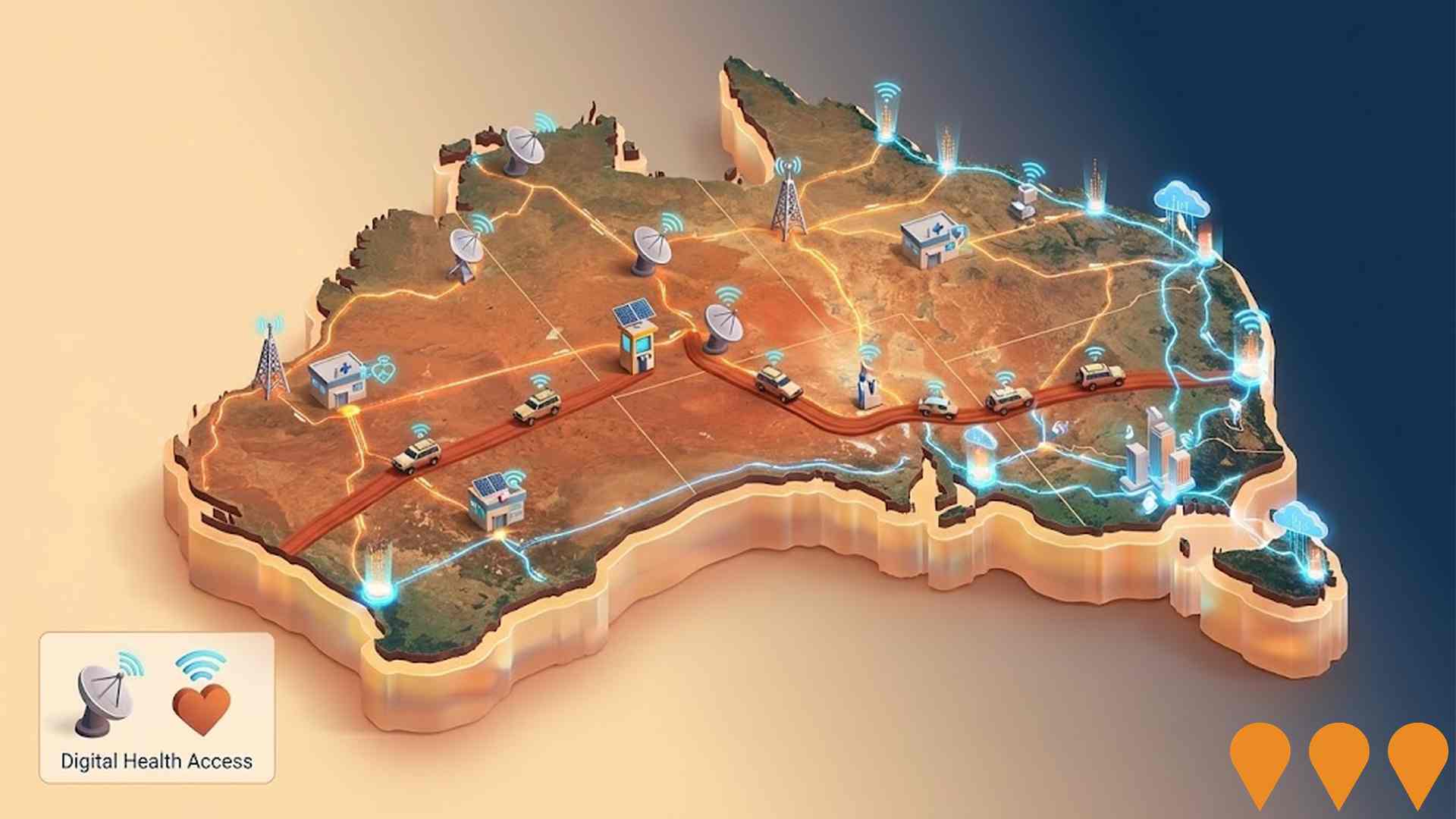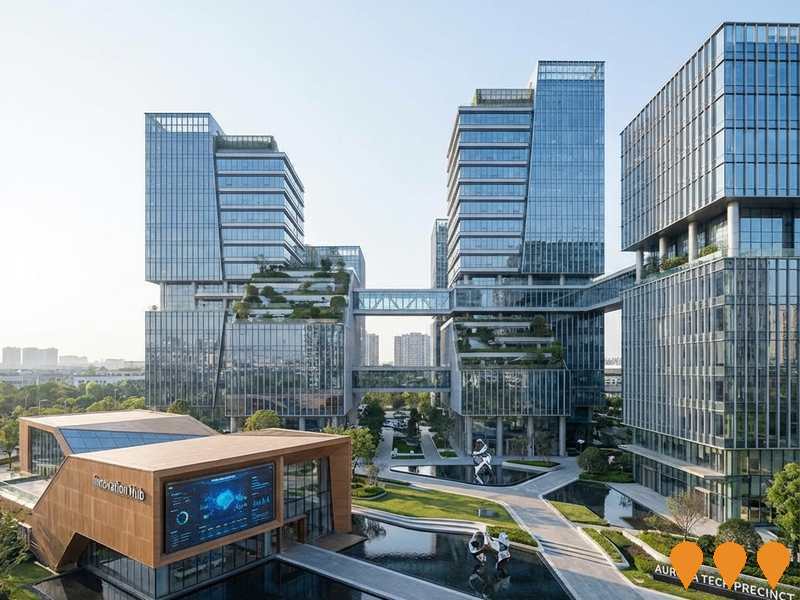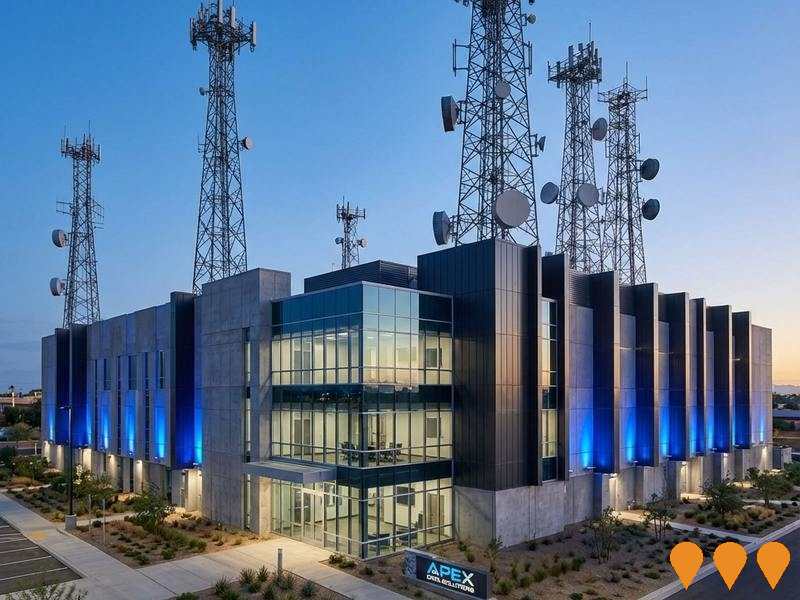Chart Color Schemes
est. as @ -- *
ABS ERP | -- people | --
2021 Census | -- people
Sales Activity
Curious about local property values? Filter the chart to assess the volume and appreciation (including resales) trends and regional comparisons, or scroll to the map below view this information at an individual property level.
Find a Recent Sale
Sales Detail
Population
An assessment of population growth drivers in Bakewell reveals an overall ranking slightly below national averages considering recent, and medium term trends
Bakewell's population, as of August 2025, is approximately 3,352 people. This figure represents an increase from the 2021 Census count of 3,091 people, marking an 8.4% rise over this period. The estimated resident population in June 2024 was 3,345, with one validated new address added since the Census date contributing to this growth. This results in a population density ratio of 2,539 persons per square kilometer, placing Bakewell in the upper quartile compared to other locations assessed by AreaSearch. The area's population growth rate of 8.4% since the census is close to the national average of 8.6%, indicating strong growth fundamentals. Overseas migration accounted for approximately 51.1% of overall population gains during recent periods, driving this growth.
AreaSearch uses ABS/Geoscience Australia projections for each SA2 area released in 2024 with a base year of 2022. For areas not covered by this data and to estimate growth post-2032, AreaSearch applies age cohort-based growth rates provided by the ABS in its latest Greater Capital Region projections (released in 2023, based on 2022 data). Future population trends indicate above median growth for Australian statistical areas. Bakewell is projected to grow by 814 persons to reach a total of 4,166 people by 2041, representing a 24.1% increase over the 17-year period.
Frequently Asked Questions - Population
Development
Residential development activity is lower than average in Bakewell according to AreaSearch's national comparison of local real estate markets
Bakewell has averaged approximately two new dwelling approvals per year over the past five financial years, totalling 14 homes. As of FY26, there have been zero approvals recorded to date. Over the previous five financial years (FY21-FY25), an average of 5.4 new residents arrived per year for each dwelling constructed, indicating a significant demand exceeding supply. Consequently, this usually results in price growth and increased buyer competition.
The average construction value of new properties is $358,000, which is below the regional average, suggesting more affordable housing options for buyers. In FY26, there have been $244,000 in commercial approvals, reflecting the area's predominantly residential nature. Compared to Greater Darwin, Bakewell has significantly less development activity, 79.0% below the regional average per person. This constrained new construction typically reinforces demand and pricing for existing dwellings, although there has been an increase in development activity in recent periods. However, this activity remains under the national average, suggesting the area's established nature and potential planning limitations. Recent building activity consists entirely of attached dwellings, which offers affordable entry pathways and attracts downsizers, investors, and first-time purchasers. This marks a significant shift from existing housing patterns, currently at 54.0% houses, indicating diminishing developable land availability and responding to evolving lifestyle preferences and housing affordability needs.
Bakewell has approximately 970 people per approval, demonstrating a mature, established area. Looking ahead, Bakewell is projected to grow by 807 residents by the year 2041. If current development rates continue, housing supply may not keep pace with population growth, potentially increasing competition among buyers and supporting stronger price growth.
Frequently Asked Questions - Development
Infrastructure
Bakewell has limited levels of nearby infrastructure activity, ranking in the 2ndth percentile nationally
No changes can significantly affect a region's performance like alterations to local infrastructure, major projects, and planning initiatives. AreaSearch has identified zero projects that are expected to impact this area. Notable projects include Darwin Light Rail Stage 1, Hudson Creek Power Station, Marine Industry Park, and Darwin Corporate Park, with the following list highlighting those most likely to be relevant.
Professional plan users can use the search below to filter and access additional projects.
INFRASTRUCTURE SEARCH
 Denotes AI-based impression for illustrative purposes only, not to be taken as definitive under any circumstances. Please follow links and conduct other investigations from the project's source for actual imagery. Developers and project owners wishing us to use original imagery please Contact Us and we will do so.
Denotes AI-based impression for illustrative purposes only, not to be taken as definitive under any circumstances. Please follow links and conduct other investigations from the project's source for actual imagery. Developers and project owners wishing us to use original imagery please Contact Us and we will do so.
Frequently Asked Questions - Infrastructure
Australia-Asia PowerLink (AAPowerLink)
The world's largest renewable energy infrastructure project, comprising a 17-20GW solar farm and 36-42GWh battery storage in the Barkly Region, connected via HVDC transmission to Darwin and Singapore. The project received Commonwealth environmental approval in August 2024. It aims to supply up to 4GW of green electricity to Darwin industrial customers and export power to Singapore.

Darwin Light Rail Stage 1
A proposed mass transit system, likely light rail or rapid bus, connecting Darwin CBD to Palmerston via the Stuart Highway corridor. The project aims to manage future population growth, reduce congestion, and improve connectivity between the two major population centres as part of the long-term Darwin Regional Transport Plan. While currently in the strategic planning phase with no immediate construction funding, the corridor has been identified for future preservation to support a '30-minute city' concept.

Enabling Digital Health Services for Regional and Remote Australia
National initiative to expand and improve digital health access for people in regional and remote Australia. Focus areas include enabling telehealth and virtual care, upgrading clinical systems and connectivity, supporting secure information exchange, and building workforce capability in digital health, aligned with the Australian Government's Digital Health Blueprint and Action Plan 2023-2033.

Desert Springs Octopus Renewable Energy Program
Majority Indigenous-owned developer pursuing a near-term pipeline of grid-connected solar and battery projects along the Darwin-Katherine Electricity System, with potential to expand into wind and green hydrogen. Partnership includes Octopus Australia with Larrakia Nation and Jawoyn Association to deliver utility-scale renewable energy and community benefit sharing.

National EV Charging Network (Highway Fast Charging)
Partnership between the Australian Government and NRMA to deliver a backbone EV fast charging network on national highways. Program funds and co-funds 117 DC fast charging sites at roughly 150 km intervals to connect all capital cities and regional routes, reducing range anxiety and supporting EV uptake.

Hudson Creek Power Station
12MW natural gas-fired power plant, NT's first privately owned grid-connected gas generation facility. Features 25% lower emissions than average NT gas generators. Part of dual project with Batchelor Solar Farm, creating 162 construction jobs and providing vital grid stability to Darwin-Katherine network.

Marine Industry Park
Marine and offshore industries servicing hub at East Arm, Darwin. Stage 1 planning approval is secured for a purpose-built industrial subdivision near the new Darwin Ship Lift, with expressions of interest open for serviced lots. Existing common-user facilities include an all-tide barge ramp (first point of entry) and a secure hardstand supporting storage and fabrication activities.

Darwin Renewable Energy Hub
Northern Territory Government proposal to co-locate up to six utility-scale solar farms (total 180-210 MW) with a battery energy storage system on 940 ha of Crown Land west of Finn Road, feeding the Darwin-Katherine grid. Site identified for industry in regional land use plans; consultation held to February 28, 2025 and environmental assessment processes are underway.

Employment
AreaSearch analysis of employment trends sees Bakewell performing better than 90% of local markets assessed across Australia
Bakewell has a skilled workforce with an unemployment rate of 1.9% as of June 2025. This is lower than Greater Darwin's rate of 3.0%.
The employment growth over the past year was estimated at 3.1%, compared to Greater Darwin's 2.9%. There are 2,049 residents in work, with a workforce participation rate of 75.8%, higher than Greater Darwin's 69.7%. Key industries include public administration & safety, health care & social assistance, and construction. Retail trade has notable concentration, at 1.2 times the regional average.
However, health care & social assistance has limited presence, with 11.2% employment compared to 14.2% regionally. Employment opportunities may be limited locally due to the predominantly residential nature of the area. Over the 12 months to June 2025, employment increased by 3.1%, while labour force grew by 2.9%, leading to a fall in unemployment rate by 0.2 percentage points. Jobs and Skills Australia's national employment forecasts from May 2025 suggest potential future demand within Bakewell. These projections indicate national employment growth of 6.6% over five years and 13.7% over ten years, with varying rates across industry sectors. Applying these projections to Bakewell's employment mix suggests local growth could be approximately 6.0%% over five years and 12.5% over ten years.
Frequently Asked Questions - Employment
Income
The area exhibits notably strong income performance, ranking higher than 70% of areas assessed nationally through AreaSearch analysis
Bakewell's median income among taxpayers was $67,199 in financial year 2022. The average income stood at $72,326 during the same period. These figures compare to Greater Darwin's median and average incomes of $65,522 and $75,260 respectively. Based on Wage Price Index growth of 12.01% since financial year 2022, estimated median income would be approximately $75,270 by September 2025, with average income projected to reach around $81,012 during the same period. According to Census 2021 data, individual earnings in Bakewell stood at the 86th percentile nationally ($1,104 weekly). Income distribution showed that 47.1% of locals (1,578 people) fell within the $1,500 - 2,999 income category. This is similar to the broader area where 36.7% occupied this range. High housing costs consumed 17.9% of income in Bakewell. Despite this, strong earnings placed disposable income at the 60th percentile nationally. The area's SEIFA income ranking placed it in the 4th decile.
Frequently Asked Questions - Income
Housing
Bakewell displays a diverse mix of dwelling types, with above-average rates of outright home ownership
Dwelling structure in Bakewell, as per the latest Census, consisted of 54.5% houses and 45.5% other dwellings (semi-detached, apartments, 'other' dwellings). In comparison, Darwin metro had 75.9% houses and 24.0% other dwellings. Home ownership in Bakewell was at 10.4%, with the rest being mortgaged (43.5%) or rented (46.1%). The median monthly mortgage repayment was $1,742, below Darwin metro's average of $2,037. Median weekly rent in Bakewell was $380, compared to Darwin metro's $400. Nationally, Bakewell's mortgage repayments were lower than the Australian average of $1,863, while rents exceeded the national figure of $375.
Frequently Asked Questions - Housing
Household Composition
Bakewell features high concentrations of group households, with a lower-than-average median household size
Family households account for 69.9% of all households, including 31.4% couples with children, 20.5% couples without children, and 17.0% single parent families. Non-family households constitute the remaining 30.1%, with lone person households at 26.1% and group households comprising 4.1%. The median household size is 2.5 people, which is smaller than the Greater Darwin average of 2.8.
Frequently Asked Questions - Households
Local Schools & Education
Educational attainment in Bakewell aligns closely with national averages, showing typical qualification patterns and performance metrics
The area's university qualification rate is 18.8%, significantly lower than the SA4 region average of 31.3%. Bachelor degrees are most common at 13.4%, followed by postgraduate qualifications (2.8%) and graduate diplomas (2.6%). Vocational credentials are prevalent, with 45.6% of residents aged 15+ holding them - advanced diplomas at 11.0% and certificates at 34.6%. Educational participation is high, with 35.2% of residents currently enrolled in formal education: 13.6% in primary, 8.7% in secondary, and 5.0% in tertiary.
Bakewell Primary School serves the area, enrolling 653 students as of a recent date. The school focuses exclusively on primary education, with ICSEA score of 968, indicating typical Australian school conditions and balanced educational opportunities. Secondary options are available in surrounding areas. School capacity exceeds local needs at 19.5 places per 100 residents, compared to the regional average of 14.7, suggesting the area functions as an educational hub for the broader region.
Frequently Asked Questions - Education
Schools Detail
Nearby Services & Amenities
Transport
Transport servicing is moderate compared to other areas nationally based on assessment of service frequency, route connectivity and accessibility
Transport analysis shows six active stops in Bakewell, offering mixed bus services. These stops are served by 23 routes, facilitating 1,144 weekly passenger trips. Transport accessibility is rated good, with residents typically located 213 meters from the nearest stop.
Service frequency averages 163 trips per day across all routes, equating to approximately 190 weekly trips per stop.
Frequently Asked Questions - Transport
Transport Stops Detail
Health
Bakewell's residents boast exceedingly positive health performance metrics with younger cohorts in particular seeing very low prevalence of common health conditions
Health outcomes data shows excellent results in Bakewell, with younger age groups having particularly low prevalence rates for common health conditions.
Approximately 55% of the total population (~1,853 people) have private health cover. The most prevalent medical conditions are mental health issues and asthma, affecting 7.7% and 6.2% of residents respectively. A total of 76.2% of residents report being free from medical ailments, compared to 76.6% in Greater Darwin. Bakewell has 6.3% of its population aged 65 and over (212 people), lower than the 7.5% in Greater Darwin.
Frequently Asked Questions - Health
Cultural Diversity
Bakewell was found to be more culturally diverse than the vast majority of local markets in Australia, upon assessment of a range of language and cultural background related metrics
Bakewell's population was found to be more culturally diverse than most local markets, with 25.0% born overseas and 20.0% speaking a language other than English at home. Christianity is the predominant religion in Bakewell, comprising 41.3% of its population. However, Hinduism shows an overrepresentation, making up 2.4% compared to 2.6% regionally.
In terms of ancestry, Australian (24.9%), English (22.5%), and Other (11.1%) are the top three represented groups in Bakewell. Noteworthy divergences include Filipino at 5.6%, Australian Aboriginal at 9.4%, and New Zealand at 0.8%.
Frequently Asked Questions - Diversity
Age
Bakewell hosts a very young demographic, ranking in the bottom 10% of areas nationwide
Bakewell has a median age of 32, which is slightly younger than Greater Darwin's figure of 34 and substantially under the Australian median of 38. Compared to Greater Darwin, Bakewell has a higher concentration of residents aged 5-14 (15.9%) but fewer residents aged 65-74 (3.8%). Between 2021 and the present day, the proportion of residents aged 15-24 has grown from 12.0% to 13.7%, while the proportion of those aged 45-54 has declined from 14.0% to 11.8%. Looking ahead to 2041, demographic projections indicate significant shifts in Bakewell's age structure, with the 45-54 age cohort projected to increase by 154 people (39%), growing from 394 to 549 residents.




